Avoiding Unfamiliar Foods?

There are so many frustrations that come with feeding a little person who can’t communicate beyond sobs and screams. But with patience and guidance, you can learn to give your children the food they need in ways they will actually appreciate. Following this guide, you will be closer to that goal, starting with ways to introduce new foods.
It’s common and natural for babies to shy away from unfamiliar foods. With so few food experiences, that makes a wide variety of foods a tough sell at first. There are a few strategies to combat this tendency, though. One is to make sure your little one eats with the rest of the family at mealtime. Babies learn by watching, and by watching their parents and siblings eating and enjoying a wide variety of foods, your infant is more likely to give them a try as well. This is important, because research shows that exposing babies to an assortment of flavors and textures sets them up for better health in the future.
Embrace the Mess

Anyone who has ever fed a little one knows this cold, hard fact: feeding babies is messy work. And exhausted parents everywhere have searched for solutions to this “problem.” But there is good reason to leave your kid alone and let him or her play. It turns out that playful tots are learning as they squish, mash, and slurp their way through their meals.
A University of Iowa study found that messy foods provide valuable object lessons for children at age 16 months. Solid objects are easier to learn because their shape remains consistent. But ooey, gooey, messy stuff—think oatmeal and baby food—is harder for young minds to fathom. So kids who are allowed to muck it up actually learn these concepts sooner.
Steering Clear of Spit-Up and Vomit

Anyone who has seen their laundry load double with a new baby knows how challenging a spitty kid can be. Why do babies spit up after feeding? Time usually cures this problem, but there are some tips that can help frustrated parents in the meantime.
One easy fix is to feed more frequently with less food. The more food in your infant’s belly, the more likely it will be to all come back up again. So try smaller servings more often.
Another approach is to burp your baby more often. Gas can bring everything back up, and if you reserve burping for the end of the meal, that leaves more time for an upset tummy.
Though you should normally wait for the six-month mark to offer solids, there are some babies who should be given a little bit of mild, solid food with their milk or formula. That’s true if your little one has difficulty swallowing (dysphagia) or if spit-up is causing heartburn (reflux). Talk to your pediatrician about best methods.
About 5% of babies have allergies or intolerances to soy or milk formulas. For these spitter-uppers, the best solution may be to switch to a hypoallergenic formula. This kind of allergy or intolerance may show other signs, such as irritability, gassiness, and poop changes.
Also, while tummy time is great for kids for the most part, you may want to forestall this ritual right after mealtime. Any additional pressure on their bellies is more likely to make what went down come back up.
‘No More Food!’
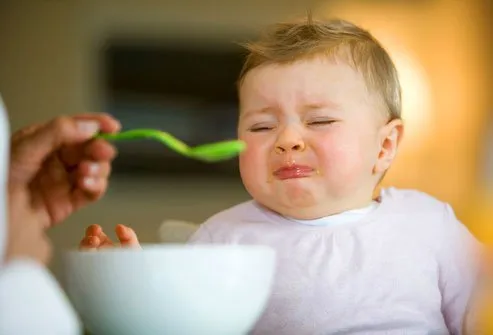
Is your little tyke putting hands over mouth when the food choo-choo comes around? Maybe the scene in your kitchen is more like King Kong fending off airplanes, with every swat directed at the feeding spoon. Whatever way your child communicates “no more food,” it’s best to respect that choice, experts say. Baby food refusal could be a sign your child is sick, distracted, exhausted, or simply full. In either case, your little one will resume eating when ready.
Why Babies are Picky

Why are babies picky eaters? Your kids are born with certain food preferences. From the start, young children prefer smooth, sweet foods that are calorie-dense. These foods are usually easy to chew and provide a lot of energy, but they don’t meet all nutritional needs. So getting your little one accustomed to new foods is important for developing healthy eating habits that can last a lifetime.
For some reason at a certain point your baby will probably start refusing new foods. There’s even a word for it: neophobia. Neophobia usually peaks at 20 months and fades away by the time a child is 5 to 8 years old. Despite this tendency, there are ways to introduce new foods early.
Handling Picky Eaters
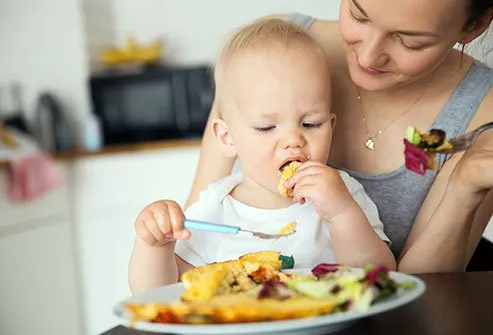
Researchers have studied what could possibly make picky eaters adapt more easily to new foods. They’ve found some solutions, too. One is breastfeeding. Because breast milk has more flavor variety than formula, this helps condition a child to accepting a wider range of foods.
But whether or not you choose to breastfeed, another effective solution is to grind your baby food at home. This can involve a blender or grinder, or simply mashing up soft foods with a fork at the dinner table. Why does this work better than baby food from a jar? Jarred food is enhanced to be more palatable. So your little one may prefer it right away, but also may refuse when trying the same food in its natural state.
Another way to introduce a wider variety of new foods in infancy is to introduce more than one food at a time. Timing is important though—this should begin right around 6 months, a time when your children will be more receptive to new flavors and textures, and also the time when they should begin solid foods. The earlier children are introduced to healthy fruits and vegetables, the more likely they are to continue eating them by the time they are 7 years old.
It’s not all about taste, though. Texture plays a big part in the way we eat, and our tongues develop the ability to move solid foods around the mouth between six and 12 months of age. This is also a great time to start introducing lumpier and more solid foods beyond a smooth puree.
Getting started early is really key. Exposing your child early to a wide variety of flavors and textures is known as the “generalization effect.” And the greater the number of new experiences your child has with food before 1 year old, the more likely your child will be to accept a wider variety of healthy foods when he is older.
Food Allergies

Food allergies can be scary. Their symptoms range from a little tingly feeling to life-threatening anaphylactic shock. Knowing what foods are prone to allergic reactions and what to do if your child develops one is important.
Is My Baby Allergic?
Sometimes allergies are confused with other things. Symptoms of food allergies include itchy skin and hives, swelling, wheezing and throat tightening, upset stomach, vomit, diarrhea, and circulation problems like pale skin and light-headedness. If your child experiences these types of symptoms, this may be a sign of anaphylaxis, and you should seek medical attention right away. The good news is that this type of reaction is rare.
However other reactions can be caused by different things. Sometimes diarrhea and vomiting are caused by food poisoning. Caffeine can make your kid jumpy and restless, and it sometimes sneaks into candy and even breast milk. Some irritated skin can be caused by the high acid content in tomatoes, orange juice, pineapple juice and the like. And sometimes diarrhea is caused by too much sugar from foods like fruit juice.
Foods That Cause Allergies
Some of the most common food allergens include the following:
- Cow’s milk
- Fish
- Wheat
- Soy
- Peanuts
- Eggs
- Shellfish
- Tree nuts (almonds, walnuts, pecans, etc.)
There’s good news, though. If your child is allergic, chances are about 80% to 90% that she will outgrow her allergies to wheat, soy, eggs, or milk by the time she reaches age 5. However, allergies to peanuts are only 20% likely to go away by age 5. Tree nut and seafood allergies are even more persistent.
Peanut Allergies
Peanut allergies need special consideration. Peanut allergic reactions can be more severe than other reactions, and about 1% to 2% of children are currently allergic. But the results of a new study could change that.
Research shows that giving infants peanut products at around 8 months reduces their chances of developing a peanut allergy by 70%. That usually means just a little bit of peanut, such as licking a spoon with a bit of creamy peanut butter. You can also introduce it into a food puree.
Crying Interrupting Mealtime?

Every baby cries sometimes. But for about one in five babies, the crying does not settle down after the infant is three or four months old. This persistent day-and-night crying is known as colic.
There are many causes of colic in babies, which can include overfeeding. Make sure to limit feeding to once every two to two and a half hours to avoid this. Another feeding issue related to colic is food sensitivity. In some rare cases, a little one may be upset from either their feeding formula or by something being passed through mother’s milk based on her diet.
Whatever the cause may be, know that a colicky tot may need to be soothed before he is willing to eat. For soothing, the American Academy of Pediatrics recommends swaddling, using pacifiers, or walking your little one in a baby carrier. Using white noise from a vacuum, fan, or clothes dryer can also help.
If you suspect your child has colic, you should consult a doctor. A pediatrician can rule out more serious causes, including hernias and illness.
Number 2 Issues

Whether it’s moving too fast or too slow, bowel issues can be scary for parents. That’s especially true for new parents, who may be wondering if everything is normal, or if it’s time to call the doctor. Here are some tips. Do you know that your baby’s poop color means something?
Seeing Green?
If a soiled diaper shows green, that’s actually normal. Healthy newborn poop color ranges from yellow to green to orange to light brown, or any combination of these. That color is caused by normally occurring bacteria as well as bile, the digestive juice used to neutralize stomach acid during digestion.
Green, yellow, and orange stools are usually no big deal. But if you see black, bright red, or a colorless/ivory color, these can be signs of a more serious condition. Colorless, pale, or ivory-colored poop may indicate bile is not being secreted and is cause to see a doctor. Black and red can indicate bleeding (dried blood can turn black), so these are also reasons to contact a doctor right away.
Diarrhea
The first thing parents should understand is what diarrhea is—and what it isn’t. Loose stool is not considered diarrhea. But if the stool is watery and is occurring as much as 12 times a day, you should check for other symptoms as well.
If your little one is under three months old, has a rectal temperature of 100.4 F or higher, vomits, refuses feeding, lacks energy, or exhibits signs of dehydration (mouth is dry, isn’t urinating for three hours or longer), call the doctor.
Constipation
Constipation is unusual in infants. And it can be easy to mistake normal behavior for a problem. Under normal circumstances, a bottle-fed baby will usually poop once a day, but she may go a day or two without passing stool. One who is breast-fed may not be feeding enough if he isn’t pooping once a day, but can actually go as long as a week between movements under normal circumstances.
If you suspect constipation, try to determine if your little one is excessively fussy, spitting up more often than usual, if the baby strains for longer than 10 minutes while trying to pass stool, or if the stool is unusually hard, particularly if it contains some blood. These can indicate real constipation.
What do you do if real constipation is suspected? You can try apple or pear juice, which can help add water to poop and make it pass more easily. Limit the juice to one ounce per month the child is old. So a three-month-old could normally be given three ounces of juice per day. If you’ve already introduced solid foods, try fruits and veggies—especially prunes. If these home remedies for constipation don’t work, call the doctor.
Doing Jar Food Safely
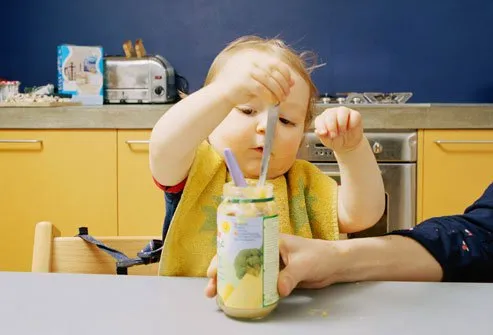
There are good reasons to consider grinding your own food for baby’s mealtime, but one big advantage store-bought jar food has is preservatives. Preservatives keep foods fresher longer, so jarred food usually doesn’t spoil quite as quickly as anything made fresh at home.
“Longer” is not the same as “forever,” though. If you’re saving jarred leftovers for the next meal, that can introduce bacteria from your baby’s mouth into the leftovers, where the bacteria can grow, potentially upsetting little tummies next time. If you’ve been doing this and notice symptoms like diarrhea or vomiting, try changing mealtime habits.
Set Healthy Patterns By Avoiding Junk Food

It’s hard to believe, but your helpless little bundle of joy grows quickly, and soon he is eating a lot of the same foods you are. But if what you eat is junk food, this can be a dangerous time for your young one’s digestive health. By introducing salty, sweet, and fatty, greasy foods early, you may be starting your child down a long road of unhealthy food habits. These habits can be tough to break, so for better health for the whole family, start making healthy food a priority in your home.
Food No-Nos

It can be so exciting introducing new foods to your baby. This should be a joyful experience, but to make sure it stays that way you should be aware of a few foods to avoid. One of these is honey if your baby is less than one year old. Honey can cause infant botulism, a very serious condition. Symptoms of botulism may include constipation, weakness, a dry mouth, drooping eyelids, blurred vision, trouble swallowing, reduced gag reflex and paralysis. Also avoid chunky foods that may pose a risk of choking such as whole grapes, hot dogs, popcorn, cheese chunks, and pulpy raw fruits and veggies.
Spices and Seasonings: Should Baby Food Be Bland?
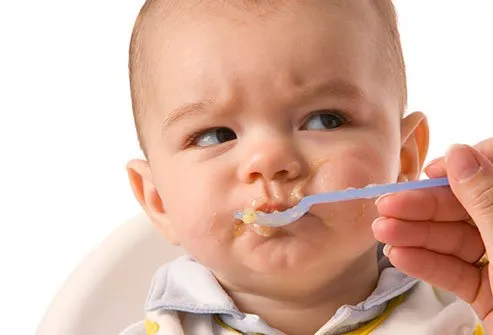
Lots of young children are fed bland, starchy food because these foods fit their natural preferences and are reliably eaten with fewer complaints. But the healthier options you really want them to eat tend to have more complicated flavors. And there’s nothing wrong with zesting up baby food, which can make an easier transition to more solid, healthy choices down the road.
When to Start Solid Foods
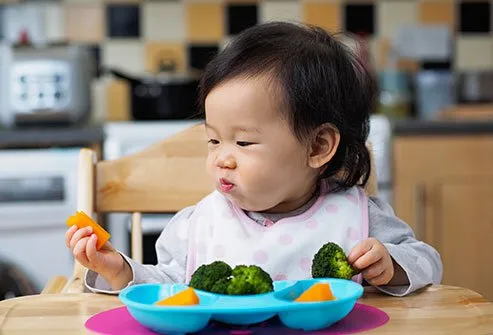
When is it time to ween your baby from the bottle? For best care, here’s what doctors have to say. Babies should not start on solid foods until they reach six months, according to the American Academy of Pediatrics. Many babies start on solids sooner—around the three-to-four-month phase. That’s especially true if you bottle-feed your baby, or if you perceive your baby as fussy. Good solid foods for baby include single-ingredient pureed vegetables and fruits, meats, and premade cereal.
But doing so poses special health threats. Babies who start solids before six months are more likely to gain weight. Not only do they often gain weight, but they gain the unhealthy kind—they get fatter. That extra weight could be setting your child up for a lifelong struggle with obesity, so stick to the advice of doctors and hold off on solid foods until the six-month mark.
Juice: Good or Bad?

Fruit juice is a common part of even the tiniest children’s diets. But doctors now recommend avoiding it completely before their first birthday. That’s because whether or not it has the word “fruit” in it, fruit juice is not particularly healthy. It shouldn’t be used as a substitute for real fruit, according to the American Academy of Pediatrics, as it can lead to obesity.
Their guidelines also suggest you limit fruit juice for kids 1-3 to four ounces a day or less. Part of the problem is tooth decay, which is particularly risky if your child has a sippy cup or juice box to draw from anytime she likes. Also, avoid any juice that is unpasteurized. Some children take medication that grapefruit juice can interfere with, so if your child is on medication, ask his doctor first.
When a Doctor Should Be Called

Are you troubled by the way your baby is eating, or not eating? If your concern isn't addressed here, or if you're noticing troubling signs like your baby losing weight, vomiting, or gagging on certain foods, you should call the pediatrician right away. That's also true if you think your baby has acid reflux, or if the child is experiencing constipation, diarrhea, or dehydration. When you have concerns about your baby's diet, don't hesitate--call the doctor.
Better Ways to Feed Your Baby
This tool does not provide medical advice. See additional information: 
© 1996-2025 WebMD, LLC. All rights reserved.